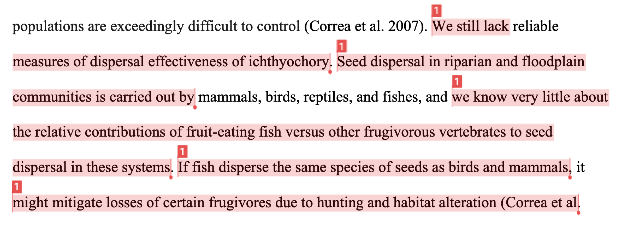In the too-close paraphrase below, the student has made some effort to rework the original source. The student has condensed some of the phrasing, merged sentences, and changed some of the wording (e.g. replaced robust with reliable). But the presentation of this language without quotes implies that the wording is the student’s. And the quantity of highlighting in the Turnitin report suggests that the student hasn’t altered or synthesized the source’s language enough to claim the words as their own—even if they give credit to the source in a citation.
Source
[W]e still lack robust quantitative measures of dispersal effectiveness and recruitment effects of ichthyochory. […] [S]eed dispersal in riparian and floodplain communities is carried out by a diverse suite of vertebrate dispersers. We know very little about the relative contributions of fruit-eating fish versus other frugivorous vertebrates to seed dispersal in these systems. If fish disperse the same species of seeds as birds and mammals, ecological redundancy among dispersers might mitigate losses of certain frugivores due to hunting and habitat alteration.1
Student Paper

When encountering this kind of too-close paraphrase, it is typically most productive to approach it as a deficit of skills rather than an issue of academic dishonesty. This student isn’t hiding his debt to the source, and it’s plausible to assume that his reliance on the source’s language comes from an inability express these ideas more clearly than the source already has.
Your goal is to teach your students how to reproduce a source’s ideas in their own language—to help them acquire the skills to write a paraphrase like this:
| Fair Paraphrase: | Source: |
|---|---|
| We are also not sure about how great a role ichthyochory plays in our modern ecosystem relative to other vertebrate frugivory. Birds, mammals and reptiles are also found on floodplains. It is unclear whether they prefer to eat and disperse different types of seeds than fishes do, and whether some of these other frugivores may help compensate for the loss of fish dispersers.2 | [W]e still lack robust quantitative measures of dispersal effectiveness and recruitment effects of ichthyochory. […] [S]eed dispersal in riparian and floodplain communities is carried out by a diverse suite of vertebrate dispersers. We know very little about the relative contributions of fruit-eating fish versus other frugivorous vertebrates to seed dispersal in these systems. If fish disperse the same species of seeds as birds and mammals, ecological redundancy among dispersers might mitigate losses of certain frugivores due to hunting and habitat alteration. |
When you receive a too-close paraphrase in a student paper, you’ll want to address the issue directly with the writer, either in person or in a comment on the paper (or both). If too-close paraphrase is an issue in several students’ work, you’ll likely also want to discuss it in class or section. This isn’t a substitute for addressing too-close paraphrase one-on-one when it happens, but discussing fair paraphrase in class can save you time by reducing how frequently it occurs in student papers.
How to Respond to the Student
The most important part of your response to the student is to make the issue clear: “You haven’t changed the language of the source thoroughly enough to claim these words as your own.”
Once a student knows what they need to learn, you can help that student be more successful on the next paper by offering strategies for paraphrasing a source. These strategies might include:
condensing the source passage (e.g. expressing the ideas from several sentences in one); considering how to adapt the source’s ideas to student’s specific argumentative purpose; replacing jargon with more standard language; identifying and trimming information and verbiage that isn’t relevant to the student’s argument.
Encourage the student to finish their next paper early and to view their own originality report on Turnitin. If the originality report raises more questions for the student, you can advise him or her to contact you or to visit the Writing Center. You can also refer the student to the Poorvu Center’s guide to Writing with Turnitin, which includes detailed strategies for paraphrasing effectively.
What You Can Do in Class
Explain to students the guidelines for fair paraphrase in your discipline. If possible, show them examples of fair and unfair paraphrases, and discuss why one example is honest and the other is plagiarism. Simply telling students that fair paraphrase is an issue you take seriously—and one you are committed to helping them learn—will go a long way in heightening students’ investment in working carefully with sources as they write.
To help students practice their skills, pass out a short selection from a course text and ask them to paraphrase it. Have them share their paraphrases in class and talk about the strategies they used to make the source’s language their own. Students will likely have questions during this exercise, so you should leave some time for discussion. To allow more time for discussion, you can have students complete their paraphrases as a Canvas post or as part of a problem set and bring their questions to class or office hours.
1Correa, S.B., et al. 2015a. Neotropical fish-fruit interactions: eco-evolutionary dynamics and conservation. Biological Reviews, 90: 1274.
2All fair paraphrases on these pages were written by Maya Juman YC ’20.
